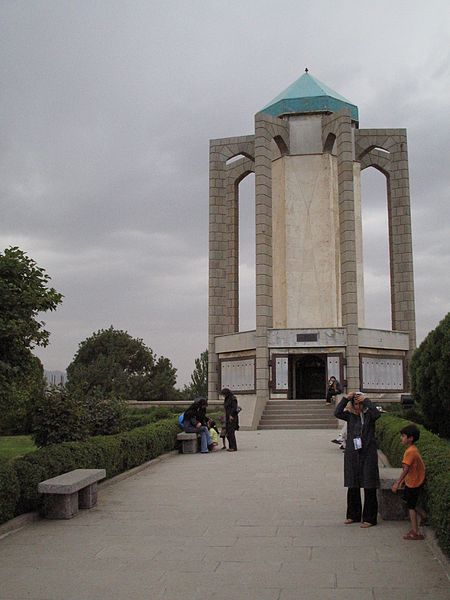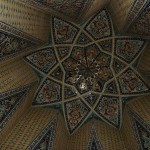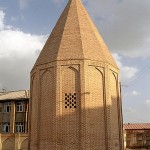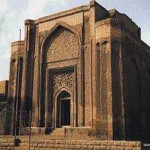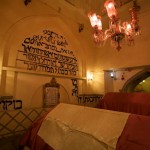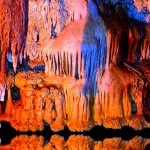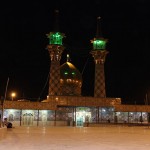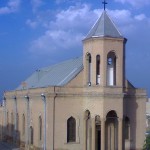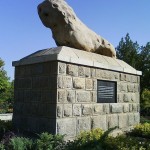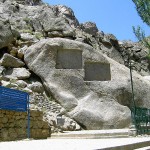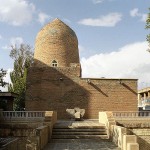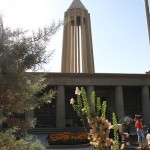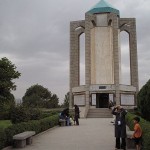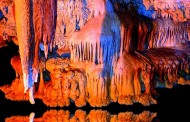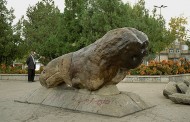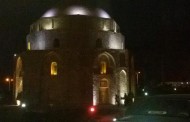Hamadān or Hamedān (Persian: Hamadān) (Old Persian: Haŋgmetana, Ecbatana) is the capital city of Hamedan Province of Iran. At the 2006 census, its population was 473,149, in 127,812 families.
Hamadan is believed to be among the oldest Iranian cities and one of the oldest in the world. It is possible that it was occupied by the Assyrians in 1100 BCE; the Ancient Greek historian, Herodotus, states that it was the capital of the Medes, around 700 BCE.
Hamadan has a green mountainous area in the foothills of the 3,574-meter Alvand Mountain, in the midwest part of Iran. The city is 1,850 meters above sea level.
The special nature of this old city and its historic sites attract tourists during the summer to this city, located approximately 360 kilometres (224 miles) southwest of Tehran.
The main symbols of this city are the Ganj Nameh inscription, the Avicenna monument and the Baba Taher monument. People of the city identify their mother tongue as Persian.
According to Clifford Edmund Bosworth, “Hamadan is a very old city. It may conceivably, but improbably, be mentioned in cuneiform texts from ca. 1100 BC, the time of Assyrian King Tiglath-pilesar I, but is certainly mentioned by Herodotus (i.98) who says that the king of Media Diokes built the city of Agbatana or Ekbatana in the 7th century BC.”
Hamadan was established by the Medes and was the capital of the Median empire. It then became one of several capital cities of the Achaemenid Dynasty.
Hamadan is mentioned in the biblical book of Ezra as the place where a scroll was found giving the Jews permission from King Darius to rebuild the temple in Jerusalem. (Ezra 6:2). Its ancient name of Ecbatana is used in the Ezra text. Because it was a mile above sea level, it was a good place to preserve leather documents.
During the Parthian era, Ctesiphon was the capital of the country, and Hamadan the summer capital and residence of the Parthian rulers. After the Parthians, the Sassanids constructed their summer palaces in Hamadan. In the year 633 the battle of Nahavand took place and Hamadan fell into the hands of the Muslim Arabs.
During the Buwayhids, the city suffered much damage. In the 11th century, the Seljuks shifted their capital from Baghdad to Hamadan. The city of Hamadan, its fortunes following the rise and fall of regional powers, was completely destroyed during the Timurid invasion. During the Safavid era, the city thrived. Thereafter, in the 18th century, Hamadan was surrendered to the Ottomans, but due to the courage and chivalry of Nader Shah e Afshar, Hamadan was cleared of invaders and, as a result of a peace treaty between Iran and the Ottomans, it was returned to Iran. Hamadan stands on the Silk Road, and even in recent centuries the city enjoyed strong commerce and trade as a result of its location on the main road network in the western region of Persia and Iran.
During World War I, the city was the scene of heavy fighting between Russian and Turko-German forces. It was occupied by both armies, and finally by the British, before it was returned to control of the Iranian government at the end of the war in 1918.
Attractions
- The Ganjnameh
- The Stone Lion
- The Saint Mary Church of Hamadan
- Tomb of Baba Taher
- The Tomb of Avicenna
- Tomb of Esther and Mordechai
- Emamzade Abdollah Mosque
- Dome of Alavian
- Qorban Tower
- Ali-Sadr Cave
- Inside the tomb of Baba Taher
- Qorban Tower
- Dome of Alavian
- Inside the structure alleged by some to be the Tomb of Esther and Mordechai
- Ali-Sadr Cave
- Emamzade Abdollah Mosque
- The handwriting of Canon of Medicine in the Tomb of Avicenna
- The Saint Mary Church of Hamadan
- The Stone Lion
- Ganj Nameh
- Tomb of Esther and Mordechai, a tomb believed by some to hold the remains of Esther and Mordechai
- The Tomb of Avicenna
- Tomb of Baba Taher
TOP SIGHTS IN HAMADAN
Ali-Sadr Cave
The Ali Sadr Cave originally called Ali Saadr or Ali Saard (meaning cold) is the world’s largest water cave which attracts millions of visitors... Read more
Tomb of Esther and Mordechai
The Tomb of Esther and Mordechai is located in Hamadan, Iran. Believed by some to house the remains of the biblical Queen Esther and her cousin Mordec... Read more
Hamadan Stone Lion
The stone lion of Hamadan (Persian: šir-e sangi-ye hamedân) is a historical monument in Hamadan, Iran. The stone lion -one part of the ‘Lions G... Read more
